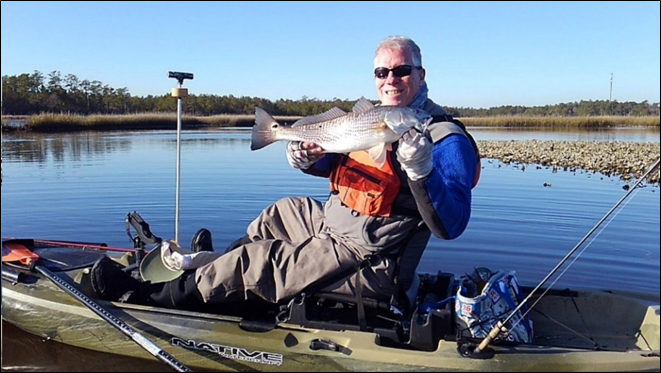Depending on how and where you do your kayak fishing, you may want to hold your kayak’s position in the water. The most commonly used system is a small anchor clipped onto an anchor trolley, a continuous loop of cord that runs over pulleys mounted on the side of the kayak. The trolleys have a ring for attaching to a clip on the anchor line. Anchor trolleys can be installed at the factory, by a kayak shop, or by the owner. But some kayak anglers are quite reluctant to drill any holes in their kayaks, even for installing a trolley. I developed a simple, removable trolley system that can go on and off quickly and involves no drilling in the kayak, plus you can take this portable system on trips when renting a kayak.

Take two short lengths of thin bungee cord (black color in the photo), tie a loop around the rear handle with one piece, and a similar length around one of the side handles. Then clip a carabiner onto each of the loops. Next, run a piece of non-stretch cord (white in the photos) between the two carabiners on the bungee and tie a small loop on either end of that cord. Adjust the length so you can clip a third carabiner to the two ends of the cord, completing a loop that slides back and forth between the side handle and the rear handle. Then you can clip the anchor line to the moving carabiner.
As for the anchor itself, a three-pound folding claw anchor with the line running through a foam pool noodle float and a clip on the end works well. Trolleying the anchor to the end of the kayak swings you more or less in line with wind or current and places less strain on the anchor. In situations where you prefer to make a slow drift, trolley the anchor to a middle position and let out enough line that the anchor touches bottom but doesn’t have enough scope to set. This turns the kayak broadside to the wind, and will cause it to drag the anchor and drift along slowly.
In freshwater rivers and areas with rocks where a grappling-style anchor may get lodged on the bottom, a better option is to bring a five-foot piece of galvanized chain and attach it to the end of your anchor line. Depending on the current, the chain will either hold you in place or slow down the drift.

Another type of anchoring system that works well in shallow water is a pole anchor, or “spud.” The pole is jabbed into the sediment and tied off to the kayak. Some anglers mount mechanical pole systems to the stern of their kayaks, some of which use a small motor to raise and lower the pole. Others who don’t require that degree of position-holding control may prefer to avoid adding another piece of equipment to their kayaks.
- Excerpted from John Veil’s latest book, “The Way I Like to Fish - A Kayak Angler’s Guide to Shallow Water, Light Tackle Fishing.” John’s books are available via Amazon.com or by emailing the author at [email protected].